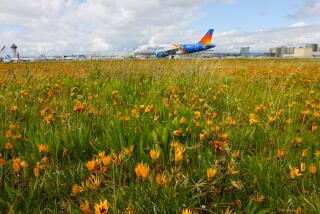Readers React: Save the birds and the butterflies — plant a native oak tree in downtown L.A.
To the editor: Kitty Connolly’s piece on sustainable native California plants and trees mentions drought tolerance and resistance to invasive insects as benefits of these flora. There are at least two more advantages they have over non-native plants.
Many of us here have developed allergies to non-native tree pollens that fly more freely though our dry air than in more humid climates. Replacing those plants with natives could help mitigate unpleasant allergies.
The other wonderful side effect is the wildlife that is attracted. After installing native plants and trees at my home, I have documented 56 species of birds visiting my yard and nesting in my trees. Monarch and mourning cloak butterflies make dozens of chrysalises, allowing me to watch the metamorphoses of these creatures.
The delight these birds and butterflies have brought to my home is immeasurable and draws me outside everyday to witness the beauty.
Kathy Harty, Sierra Madre
..
To the editor: Three cheers for Connolly of the Theodore Payne Foundation for Wild Flowers and Native Plants for suggesting a coast live oak for El Pueblo de Los Angeles Historical Monument’s plaza.
Here in Manhattan Beach, we also embrace native and environmentally appropriate plants and encourage everyone to nurture more sustainable landscapes. In fact, this year we are proclaiming “The Year of the Butterfly” not only to celebrate the recent migration of the Painted Ladies through our region, but to bring attention to the stunning demise of the monarch population.
Everyone should plant native milkweed and other pollinator-friendly plants to help the monarch recover. If not, you may have just seen the last monarch in the wild.
Charlotte Marshall, Manhattan Beach
The writer is president of the Manhattan Beach Botanical Garden.
..
To the editor: I agree completely with Connolly about planting a coast live oak at El Pueblo. However, there are some drawbacks to the tree.
The oak produces numerous strings of tiny flowers in spring called catkins, the pollen from which is very bad for people with allergies. I know — I lived in a condo with this oak next door for 15 years, and I practically had to stay inside while it was releasing pollen.
The other problem is that the tree should not be watered within several feet of the trunk, which precludes the planting of flowers around the base. Most flowers used in landscaping require more frequent watering than a coast live oak, making for an incompatible combination.
As long as everyone involved in caring for the tree understands the watering requirements, it should remain healthy. But if it is watered like any other plant, it will not flourish.
George Izaguirre, Claremont
Follow the Opinion section on Twitter @latimesopinion and Facebook
More to Read
A cure for the common opinion
Get thought-provoking perspectives with our weekly newsletter.
You may occasionally receive promotional content from the Los Angeles Times.






